|
Putting Our Best Signal Forward
By: Leonard David
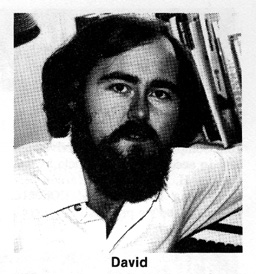 As the evidence builds that we are but part of a great galactic neighborhood, is it possible that we
can communicate with aliens next door?
As the evidence builds that we are but part of a great galactic neighborhood, is it possible that we
can communicate with aliens next door?
Some scientists warn that attempts to contact extraterrestrial intelligences should be restrained for fear of invasion by hostile beings. But in truth, messages from Earth are on their way outward, some sent by accident, others intentional. Satellites, space probes, radar telescopes have been used in an endeavor to convey our presence to other civilizations. Even President Carter had his hand at drafting a message to the stars — but more about this later.
And just how do you go about conversing with the cosmos? Try this:
Play a D
Now up a whole note
Now down a third
Now down an octave
Now up a perfect fifth
No this is not instruction from someone's piano teacher, but a method for communicating with extraterrestrial intelligence, by way of music. In his score for "Close Encounters of the Third Kind," conductor John Williams used this simple musical theme to establish a common language between the alien mother ship and an enraptured ground crew. The result was an explosion of musical exchanges so complex that a computer had to be used to keep up Earth's end of the conversation.
The thought of using the language of music for an alien encounter is not new. Dr. Lewis Thomas, author of "The Lives of a Cell: Notes of a Biology Watcher," suggests the use of a Bach concerto to announce our presence in the universe. Thomas believes that music would provide the extraterrestrials with knowledge of who and what we are. "I would vote for Bach," Thomas states, "all of Bach, streamed out into space, over and over again. We would be bragging of course, but it is surely excusable for us to put the best possible face on the beginning of such an acquaintance. We can tell the harder truths later."
It is probable alien intelligences already know the harder truths. The brilliant burst of light and energy from our first atomic bomb blast in 1945 produced a definite signal that intelligent (?) life on this planet had reached a certain level of technology. Those pulses of electromagnetic energy from initial atomic testing now stretch over 30 light years from Earth, crossing the paths of hundreds of stars, some of which may foster inhabited planets.
With the introduction of radio, television and powerful military radars, the Earth has evolved over several decades into an inadvertent beacon of human technology. To super-intelligent aliens we are most certainly "banging the village drums" in our part of the universe. One could imagine extraterrestrial scientists sifting through the buzz and static of the universe with sophisticated instruments, locating waves of information from our planet — a blend of I Love Lucy, the Lone
Ranger, Buck Rogers and Captain Video. Indeed, signals from Earth would relay a confusing picture of our species. From the clatter, aliens could easily surmize that "the natives are restless."
But this form of planetary babbling does not represent the serious efforts which have been undertaken to connect with the cosmos; to send signals of meaning, describing our species and extending an interstellar handshake and hello to our neighbors. As early as the 19th Century, methods were concocted to signal our presence to extraterrestrial intelligences. Although not carried out, consideration was given to shaping pine forests in Siberia to form a Pythagorean triangle. Others suggested the use of reflecting sunlight with mirrors or digging a twenty-mile trench in the Sahara, filling it with kerosene, and setting it ablaze.
|
Four Messages from Earth
Pioneer: The radiating lines at left represent the positions of 14 pulsars — cosmic sources of radio energy — arranged to indicate our Sun as the home star of the launching civilization. The "1-" symbols at the ends of the lines are binary numbers that represent the frequencies of these pulsars at the time of launch of Pioneer, relative to that of the hydrogen atom shown at the upper left with a "1 " unity symbol.
The hydrogen atom is thus used as a "universal clock" and the regular decrease in the frequencies of the pulsars will enable another civilization to determine the time that will have elapsed since Pioneer was launched. The hydrogen atom also is used as a "universal yardstick" for sizing the human figures and outline of the spacecraft, shown on the right. The hydrogen wavelength — 21 centimeters — multiplied by the binary number representing "8" shown next to the woman gives her height — 1.7 meters. The figures represent the type of creature that created Pioneer. The man's hand is raised in a gesture of good will. Across the bottom are the planets, ranging outward from the Sun, with the spacecraft's trajectory arching away from Earth, passing Mars, and swinging by Jupiter.
 Arecibo radio message (at left): The beamed message is composed of 1,679 binary pulses, represented by zeroes and ones. When the dots are arranged into 70 consecutive groups [sic; "70" should be "73"] of 23 characters, with "0" as a white square and each "1" as black, a visual message appears. Starting from the top right, the numbers one to ten are described in binary form. This provides a language which is used to translate the following message. The next symbols below display the atomic numbers of hydrogen, carbon, nitrogen, oxygen and phosphorus, the basic chemicals of life. Proceeding down further, the message uses the preceeding information to describe the building blocks of D.N.A. and in fact depicts the double-helix pattern of D.N.A. The core of the D.N.A. structure represents the number 4,000 million, roughly the number of characters which constitute the genetic code. Added up, these parts of the Arecibo message describe the chemical basis of Earth life.
Arecibo radio message (at left): The beamed message is composed of 1,679 binary pulses, represented by zeroes and ones. When the dots are arranged into 70 consecutive groups [sic; "70" should be "73"] of 23 characters, with "0" as a white square and each "1" as black, a visual message appears. Starting from the top right, the numbers one to ten are described in binary form. This provides a language which is used to translate the following message. The next symbols below display the atomic numbers of hydrogen, carbon, nitrogen, oxygen and phosphorus, the basic chemicals of life. Proceeding down further, the message uses the preceeding information to describe the building blocks of D.N.A. and in fact depicts the double-helix pattern of D.N.A. The core of the D.N.A. structure represents the number 4,000 million, roughly the number of characters which constitute the genetic code. Added up, these parts of the Arecibo message describe the chemical basis of Earth life.
Next is a cryptic representation of the human form, with a measure of height given to the right, and the approximate number of the human population on the left. This is followed by symbols relating the planets of our solar system, with the Earth displaced toward the human. The bottom three sections describe the Arecibo telescope itself, the message it has beamed and indicates the 300 meter size of the Arecibo installation.
The Arecibo Message was designed by Frank D. Drake and the staff of the National Astronomy & Ionosphere Center (NAIC). (The Arecibo Observatory is part of the NAIC which is operated by Cornell University under contract with the National Science Foundation.)
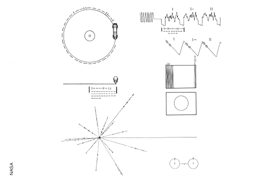 Voyager: In the upper left corner [in the drawing to the right] is a drawing of the phonograph record and the stylus carried with it. Written around it in binary arithmetic is the correct time of one rotation of the record, 3.6 seconds, expressed in time units of 0.70 billionths of a second. The drawing indicates that the record should be played from the outside in. Below this drawing is a sideview of the record and stylus, with a binary number giving the time to play one side of the record, about one hour. The information in the upper right portion of the record is designed to show how pictures are to be constructed from the recorded signals.
Voyager: In the upper left corner [in the drawing to the right] is a drawing of the phonograph record and the stylus carried with it. Written around it in binary arithmetic is the correct time of one rotation of the record, 3.6 seconds, expressed in time units of 0.70 billionths of a second. The drawing indicates that the record should be played from the outside in. Below this drawing is a sideview of the record and stylus, with a binary number giving the time to play one side of the record, about one hour. The information in the upper right portion of the record is designed to show how pictures are to be constructed from the recorded signals.
The upper right drawing [again in the drawing to the right] shows the typical wave form which occurs at the start of a picture. Picture lines 1 , 2, and 3 are noted in binary numbers, and the duration of one of the "picture lines," about 8 milliseconds, is noted. The drawing immediately below shows how these lines are to be drawn vertically, with a staggered interlace to give the correct picture rendition. Below this is a drawing of an entire picture raster, showing 512 vertical lines in a complete picture. Immediately
below this is a replica of the first picture on the record, allowing the recipients to verify that they are decoding the signals correctly. A circle is used to insure correct aspect ratio in reconstructing the picture.
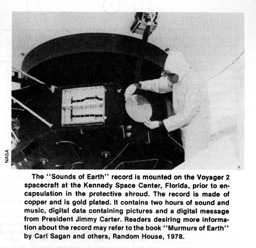
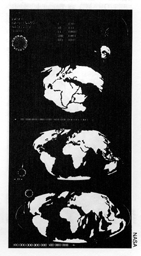 Lageos (at right): In the upper center, the message displays the simplest counting scheme, binary arithmetic, which uses only zeros and ones. The numbers one through 10 in binary notation are shown. At the upper right is a schematic drawing of the Earth in orbit around the Sun, an arrow indicates the direction of motion. The arrowhead points to the right, indicating the future. All arrows accompanying numbers represent "arrows of time." Under the Earth's orbit is the binary number one, denoting the period of time used on the plaque — one revolution of the Earth about the Sun, or one year.
Lageos (at right): In the upper center, the message displays the simplest counting scheme, binary arithmetic, which uses only zeros and ones. The numbers one through 10 in binary notation are shown. At the upper right is a schematic drawing of the Earth in orbit around the Sun, an arrow indicates the direction of motion. The arrowhead points to the right, indicating the future. All arrows accompanying numbers represent "arrows of time." Under the Earth's orbit is the binary number one, denoting the period of time used on the plaque — one revolution of the Earth about the Sun, or one year.
Beneath the first map, an arrowhead pointing left denotes the past and connects to a large binary number. In decimal notation this number is equivalent to about 268 million years ago, with the picture showing how many believe the Earth once appeared. The middle drawing represents the Earth as it appears today, and shows the Lageos being launched from California in a southerly direction. The zero with arrows pointed left and right indicates the present time. The final part of the Lageos message depicts the return of the satellite to Earth, with binary numbers and arrow indicating the approximate number of years following its launching. Geophyicists believe that, given the theory of continental drift, the Earth's land surfaces will have moved to locations as drawn on the final map.
|
A little known concept of cosmic conveyance to other planetary inhabitants was espoused by American rocket pioneer Robert Goddard in the 1920s. The imaginative engineer wrote to the Smithsonian Institution that, given the existence of intelligent beings on other worlds, a possible communications method " ... would consist in the sending of devices to the planets that would produce a succession of colors on falling through the atmosphere: the devices containing metal sheets stamped with geometrical figures; with the constellations emphasizing the Earth and the Moon..."
Today we find projects to announce our existence a little more complex, taking advantage of new space age technologies. Launched in 1972 and 1973, a couple of interplanetary robots named Pioneer 10 and 11 carried with them the first serious undertaking to contact alien civilizations. With their primary mission of investigating the planet Jupiter now complete (Pioneer 11 flew by Saturn in 1979), both carry a message from Earth, destined to leave our solar system and wander among other stars. With an exit velocity of around 11 kilometers per second, the Pioneers would not reach the nearest star for some 80,000 years, if in fact they were headed in that direction — which they are not.
Perhaps sometime in the future, an interstellar cruiser, noticing something off its bow, will pull alongside and haul a Pioneer onboard. Upon close examination of one section of the space-weathered exterior, strange but distinct scratches would be found. There, etched on a 15 by 22 centimeter gold-anodized aluminum plate, a message from some far-off planet, written in the cosmic language of all intelligences — science.
The Pioneer plaque, identical on both spacecraft, is designed to show inhabitants of other star systems when Pioneer was launched, from where, and by what kind of beings. Creator of the message, noted astronomer Dr. Carl Sagan, received assistance in its design by his artistic wife Linda Sagan and his radio astronomy colleague, Dr. Frank Drake. According to some estimates, eight average research scientists locked in a room all day should be able to decipher the meaning of the cosmic plaque.
As the old saying goes, "a picture is worth a thousand words," which is what the editor of the Los Angeles Times received from an irate reader when the newspaper ran a photograph of the plaque. "I must say I was shocked," protested the angry reader, "by the blatant display of both male and female sex organs on the front page of the Times." Continuing, the reader asserted "Isn't it enough that we must tolerate the bombardment of pornography through the media of film and smut magazines without our own space agency officials having found it necessary to spread this filth even beyond our own solar system?" Other public reaction complained that the man's upheld arm could be misconstrued as a form of Hitlerism, while religious organizations felt the message conveyed everything but God. From all the reaction stirred by the message, it would seem a follow-on Pioneer should be built to contain all the protests, providing a true picture of planet Earth's varying degrees of intellect!
Although current plans of searching for intelligent alien life have been geared to listening with radio telescopes, on November 16, 1974, a radio message was broadcast to the stars. On that day, the giant Arecibo radio telescope in Puerto Rico, transmitted a powerful three minute signal. The target? A globular cluster of stars in the constellation Hercules, 24,000 light-years away. By the time it reaches it destination, the beam will have spread itself to cover all 300,000 stars in the cluster, thus wasting none of its power — the first attempted interstellar broadcast practicing energy conservation!
As with the case of Pioneer, the team of Carl Sagan and Frank Drake was responsible for the signal's content. The beamed message would humble even Western Union. This "SETIGRAM", as Sagan labels it, describes the biochemistry of the human species, depicts our solar system, and contains a diagram of the Arecibo radio telescope. If there is a comparable radio telescope based somewhere in the Hercules star cluster, the message could be received, decoded, and a proper return signal generated. But the alien response wouldn't arrive here on Earth until about 50,000 A.D., which doesn't make it a snappy conversation!
Now circling nearly 4,000 miles above us, there exists another attempt to relay a message to advanced civilizations. Launched in May of 1976, a 60 centimeter, 400 kilogram sphere dubbed "Lageos," for Laser Geodynamic Satellite is now in Earth orbit.
This over-sized, golf-ball looking spacecraft contains no electronics, but is made up of hundreds of prism reflectors. By using a laser beam originating from Earth, and striking the prisms, scientists are studying continental drift, the Earth's rotation and wobble about its axis as well as movement along geologic faults, possibly aiding in earthquake prediction.
The stability of the Lageos orbit is so great that it will not be dragged in by the Earth's atmosphere or gravitation forces for an estimated 8 million years. Backed by the success of the Pioneer message, Carl Sagan was requested to design a similar plaque for Lageos. The result was two copies of a message, etched on stainless steel sheets, measuring just 10 by 18 centimeters. The plaques are contained inside the satellite, one on each end of a connecting bolt that holds the two
hemispheres of Lageos together. The plaques graphically and mathematically describe the mission of the spacecraft, when and from where it was launched. Three drawings show the position of the continents, 200 million years ago when they were grouped together, the way they are now, and where scientists anticipate them to drift in the next 10 million years.
Explains Sagan, "I have opted for the simplest possible representation which clearly conveys the existence and timing of continental drift and the connection of Lageos with continental drift. I also wanted to give considerable prominence to the remarkable geographical changes which have been brought about by plate tectonics."
In a very real sense, Lageos is an attempt to communicate with a future terrestrial super-intelligence — earthlings. Thanks to its long lifetime, Lageos is a time capsule in space from our civilization. Future Earth generations, changed by evolutionary biological processes, will find Lageos a footnote in Earth's space chronicles — a greeting card from the remote past.
The most recent attempt to chat with other star-folk involves the Voyagers 1 and 2, launched in August and September of 1977. The space probes are bound for a non-stop, scientific tour of the outer planets, Jupiter and Saturn, along with inspection of several of their respective moons. One Voyager might take a side-trip to Uranus as well. Both spacecraft will eventually drift out of the solar system and glide outward to other stars.
The Voyagers carry what represents a 20th Century, multi-media attempt to notify the universe of our existence and without commercial interruption. As with earlier efforts, Carl Sagan remains as the man-behind-the message. On this occasion however, Sagan assembled a committee of prominent scientists and educators to assist in developing the Voyager communique. Sagan originally had considered an advanced Pioneer plaque, but encouraged by members of the committee, a message with higher "information density" was agreed upon.
The final product was a 30 centimeter diameter, 16 and 2/3 r.p.m., two-hour long phonograph record, titled "Sounds of Earth." Developed in commemoration of the 100th anniversary of the invention of the phonograph by Edison, the record is a potpourri of items, including greetings from Earth people in different languages, samples of music from numerous cultures and eras, as well as natural sounds of surf, wind, thunder, birds, whales and other animals.
Each Voyager carries its phonograph record in an aluminum container, complete with porcelain cartridge, diamond stylus, and topped off with playing instructions. The actual recording begins with 115 pictures, electronically encoded within the grooves. Selected primarily by Frank Drake, photographs of human beings representing a variety of countries, landscapes of Earth, airplanes, varying aspects of human life, and views of our solar system, filter in and out of the collection. Quickly following is a written message from President Carter, a listing of congressional leaders (most likely an attempt to cultivate a future alien political vote), and a spoken greeting from U.N. Secretary General Kurt Waldheim. Waldheim's remarks are concise:
As the Secretary General of the United Nations, an organization of 147 member states who represent almost all of the human inhabitants of the planet Earth, I send greetings on behalf of the people of our planet. We step out of our solar system into the universe seeking only peace and friendship, to teach if we are called upon, to be taught if we are fortunate. We know full well that our planet and all its inhabitants are but a small part of the immense universe that surrounds us and it is with humility and hope that we take this step.
Next are greetings in 55 languages, including a small child speaking English, simply stating, "Hello from the children of planet Earth." The greetings are part of a "sound essay" which depicts Earth's evolution of biology and technology, represented by sounds from volcanoes, rain, ocean waves to animal noises, a human heartbeat and footsteps, a Saturn V liftoff, laughter, and even a kiss.
The remaining three quarters of the record is comprised of music, varying from Indian chants, flutes, and percussion pieces, to Bach, Beethoven, Stravinsky and a touch of Louis Armstrong and Chuck Berry for flavor. Apparently a hot debate took place regarding the selection of Chuck Berry's "Johnny B. Goode." Some members of the committee flatly stated there is no place in the universe for rock-and-roll. Younger members of the team protested, and later won, arguing that rock-and-roll is a product of diverse cultures, with the United States its birthplace.
As the Voyager recordings slip into the cosmic void, chances are good we will never hear how it is rated on a "galactic top-ten." One can only hope that who or whatever recovers the recording will have some kind of visual imaging and audio-sensing system. Perhaps the Voyagers, record and all, will wind up a meal for some alien life form, fond of aluminum and gold!
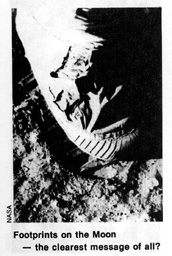 But our space exploration efforts have produced one additional message — the inhabitants of this planet have developed spaceflight. Artifacts of our civilization are strewn throughout the solar system; satellites now orbit the earth, Soviet and American probes bask on other planets, and vehicles are making their way to interstellar distances. More importantly, the Moon holds the clearest signal of all from Earth. If our planet were to vanish tomorrow, the Moon's vacuum and dusty surface have protected the technological highwater mark of our species: footprints. Preserved like that of the extinct dinosaur, Earthkind, the human robot, has left an imprint in the universe.
But our space exploration efforts have produced one additional message — the inhabitants of this planet have developed spaceflight. Artifacts of our civilization are strewn throughout the solar system; satellites now orbit the earth, Soviet and American probes bask on other planets, and vehicles are making their way to interstellar distances. More importantly, the Moon holds the clearest signal of all from Earth. If our planet were to vanish tomorrow, the Moon's vacuum and dusty surface have protected the technological highwater mark of our species: footprints. Preserved like that of the extinct dinosaur, Earthkind, the human robot, has left an imprint in the universe.
There have been scientists who suggest that phonograph records, plaques and etched messages to extraterrestrial intelligent life are mindless public relation gimmicks — standing in the way of "good" science. Others argue that the first contacts will come only through listening with upgraded radio telescopes. A few members of the scientific community point to newly developed lasers as a more reasonable way to conduct business. It is conceivable, and probable, that Earth is bombarded with daily messages from distant aliens, but their recognition and interpretation call for communication techniques yet to be developed or understood.
Our efforts to date may be as archaic as throwing cave paintings and ancient hieroglyphics into deep space. Perhaps they are as feeble an attempt as reflecting sunlight or setting the torch to gigantic bonfires. But it remains vitally important that we are attempting, however minimally, to reach out to other civilizations. To do less would be to put chains on our sense of inquiry and the exploration of the unknown. As Setiologist, Bernard Oliver, Vice President of Research and Development for Hewlett-Packard, recently stated, "How can we remain galactic recluses, forever ignorant of the mainstream of life?"
Through our inadvertent and planned messages, we have rung the doorbell of our galactic neighborhood, waiting to see if anyone is at home. With our first radio and television signals already passing locations in space that could be inhabited, the door to the universe may soon be
opening.
 Leonard David is Director of Space Data Resources and Information (SDR&I), a private consulting organization in Washington, D.C. He is currently involved in research for the Planning
Research Company, concerning the development of the solar power satellite concept.
Leonard David is Director of Space Data Resources and Information (SDR&I), a private consulting organization in Washington, D.C. He is currently involved in research for the Planning
Research Company, concerning the development of the solar power satellite concept.
He has been a frequent contributor to magazines, such as OMNI and Future Life, is Senior Editor for Aviation Space magazine, and editorial consultant for the American Institute for Aeronautics and Astronautics Student Journal.
Mr. David was formally Program Director for the Forum for the Advancement of Students in Science and Technology (FASST), organizing numerous conferences, symposia, and workshops on space exploration, including the search for extraterrestrial intelligence.
Statement by U.S. President Jimmy Carter
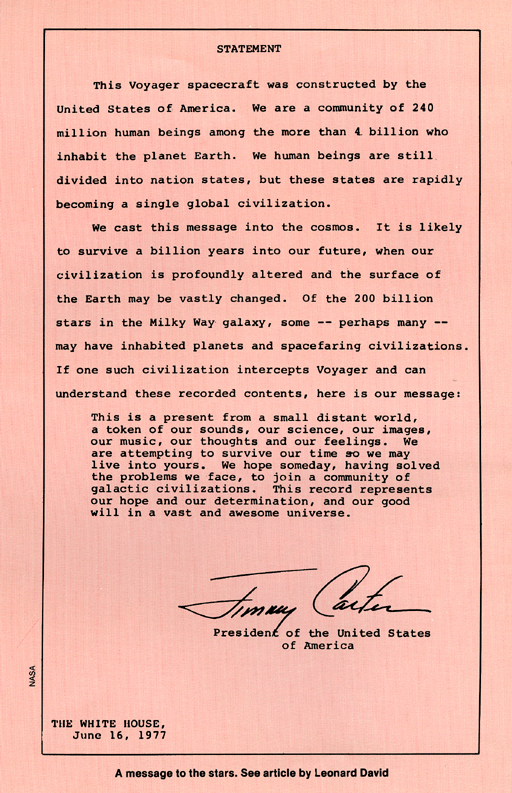
|
![[NAAPO Logo]](../../Images/NAAPOsm.jpg)
![[NAAPO Logo]](../../Images/NAAPOsm.jpg)